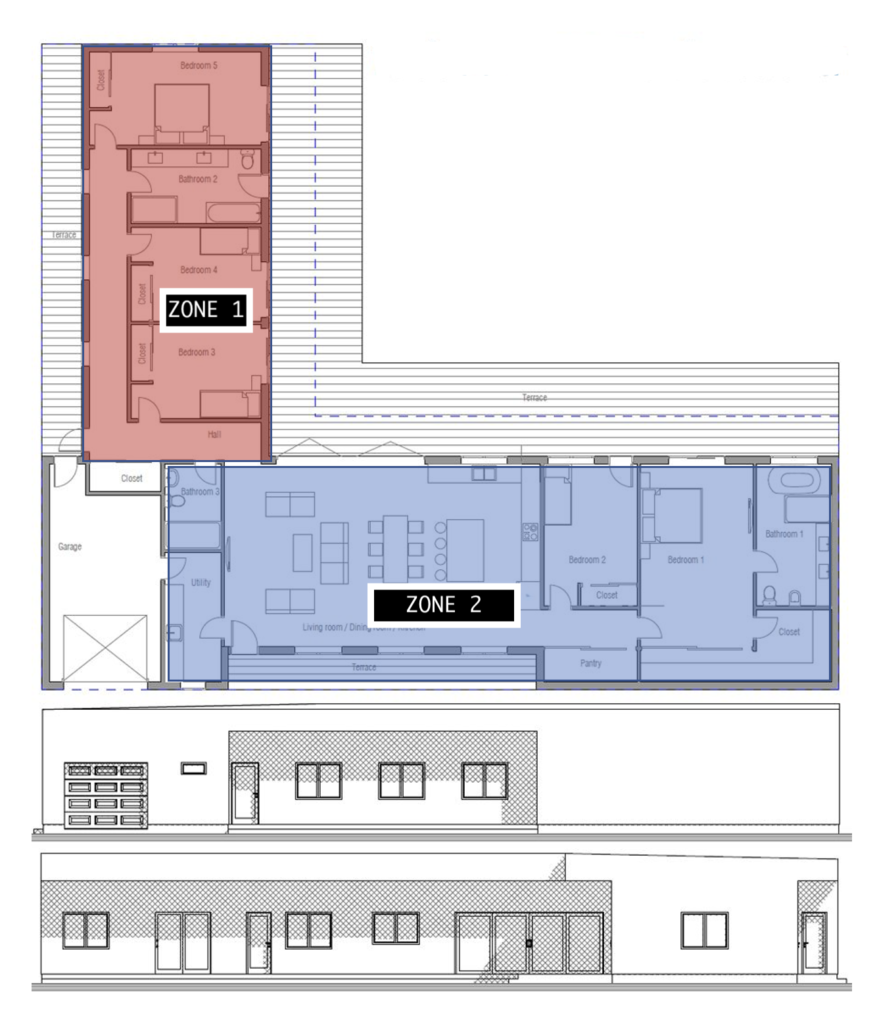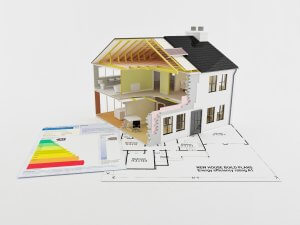HVAC Equipment Zoning
Recently a homeowner outside of the Magic Touch Mechanical service area contacted me with questions about HVAC equipment zoning. He wasn’t asking about a true ‘zone system’ (using motorized dampers in the ductwork), his inquiry was about ‘equipment zoning’.

HVAC Equipment Zoning vs a Zone System
- A zone system aka zoning works by sending more (or less) airflow to an area using 1 HVAC system & a shared duct system. Zone sensors send a signal to electronic dampers in the ducts telling them to either open or close.
- HVAC equipment zoning is the concept of conditioning the air using 2 or more HVAC systems and separate duct systems.
New AC Unit Not Keeping the Home Comfortable
 To better understand the concept of equipment zoning, let me describe the home he described and the proposals he’d received.
To better understand the concept of equipment zoning, let me describe the home he described and the proposals he’d received.
He purchased a large single-story home that was “L shaped”. The bedrooms were all on one side of the “L”, and the common areas on the other. The home was originally built with a single air conditioning & heating system which cooled and heated the entire home. Although the unit was replaced only a few years prior to purchasing the home, his family wasn’t comfortable.
He’d hired an energy auditor to complete an “extensive audit,” and had the ductwork & insulation inspected by multiple companies. He even went as far as paying a contractor to complete a load calculation to determine if the HVAC equipment was properly sized. I was impressed with the level of detail he’d gathered. He then shared that much of what he’d done he learned from reading many past articles on our blog!
He said he’d searched our website looking for more information on HVAC equipment zoning but couldn’t find any. That inspired me to write this article. I know this information will help other people with similar home comfort issues find the answers they need.
Heating & Air Contractor Recommends HVAC Equipment Zoning
After receiving multiple quotes (and different advice) from several HVAC Contractors, one proposed solution stood out from the rest. The contractor proposed replacing the existing single air conditioner & heating system with two smaller capacity HVAC systems. This would require modifying the entire duct system to convert it into two completely independent duct systems – one for each side of the “L”.
What this contractor proposed is, HVAC equipment zoning. Each ‘zone’ of the house (each side of the ‘L’) would be heated and cooled by its own system. What the homeowner wanted to know was:
- Do I recommend HVAC equipment zoning for his situation?
- Did Magic Touch Mechanical have experience with HVAC equipment zoning?
- If so, what were the results?
- Was it worth the “significantly more money,” to replace one unit with two?
- Should he consider whole-home ductless mini splits which was, in his words, “far more money than he was comfortable spending.”
Do I Recommend HVAC Equipment Zoning?
In this situation and similar situations, I do believe HVAC equipment zoning was one of the better recommendations he received. Of course, I was only able to make this assessment due to the other information he’d already gathered.
For example, the load calculation had determined the current equipment’s capacity (tonnage) was correct for the home (properly sized equipment).
The energy audit report determined the issue was more related to the HVAC system’s duct design than duct leakage. The report also found that the home was relatively tight and insulation deficiencies weren’t a contributing factor.
Splitting the existing single 5-ton air conditioner into two units operating independently of one another I.E., HVAC equipment zoning makes sense in this scenario. By splitting the home into two separate zones, each side can be set to more comfortable settings without freezing out some rooms to compensate for warmer rooms. Also, by shortening excessively long duct runs the home will heat and cool more quickly and efficiently.
The Results We’ve Seen on Our Own Projects
I can summarize the 2nd and 3rd questions together in one paragraph. Yes, my team has recommended HVAC equipment zoning many times. In fact, there’s a neighborhood in Phoenix where we implemented an HVAC equipment zoning plan for 4 neighbors. These are 2-story homes originally equipped with one system for both floors. It was a poor design by the builder – clearly more focused on saving money over homeowner comfort. Upon completing the first home, the neighbors started talking – we have since converted 4 homes in that neighborhood.
Is it Worth the “Significant Price Difference”?
 What something is “worth” is subjective. That said, it was his discomfort that set him on a mission for a solution. He shared the quotes he had received from different HVAC contractors. The contractor that proposed HVAC equipment zoning submitted an estimate that was almost 3x more than quotes to upgrade the existing unit. That said, the differences in the scope of work, labor, and materials proposed was like comparing apples to oranges. I responded, “if the end goal is to make the home comfortable once and for all, this will do it. The quotes to replace your existing equipment with better equipment will improve things, however they won’t fix it completely. You need to decide what you’re willing to ‘live with,’ and what fixing it for good is worth to you.”
What something is “worth” is subjective. That said, it was his discomfort that set him on a mission for a solution. He shared the quotes he had received from different HVAC contractors. The contractor that proposed HVAC equipment zoning submitted an estimate that was almost 3x more than quotes to upgrade the existing unit. That said, the differences in the scope of work, labor, and materials proposed was like comparing apples to oranges. I responded, “if the end goal is to make the home comfortable once and for all, this will do it. The quotes to replace your existing equipment with better equipment will improve things, however they won’t fix it completely. You need to decide what you’re willing to ‘live with,’ and what fixing it for good is worth to you.”
Ductless Mini Split Units vs HVAC Equipment Zoning
 One contractor suggested removing the ductwork from the equation completely and installing a whole home ductless mini split system. In essence, he too was suggesting HVAC equipment zoning, albeit on a much larger scale. Multi-zone mini split heat pumps basically divide each area or room into its own zone. The contractor proposed an 8-zone mini split system, which from the information I had; was very well thought out.
One contractor suggested removing the ductwork from the equation completely and installing a whole home ductless mini split system. In essence, he too was suggesting HVAC equipment zoning, albeit on a much larger scale. Multi-zone mini split heat pumps basically divide each area or room into its own zone. The contractor proposed an 8-zone mini split system, which from the information I had; was very well thought out.
Unfortunately for that contractor, this homeowner already answered his own question by saying it’s, “far more than I’m comfortable spending.” He asked if the quote was fair. Based solely on the info I had, I said it did seem to be in the right ballpark. Having designed and installed many multi-zone mini split systems, it’s not surprising to see them come in at 4-5x the cost of conventional central air replacements.
I explained that both contractors were offering “solution based” recommendations. Both seemed to have the homeowners end goal in mind – making the home comfortable. Seeing as he wasn’t even “comfortable spending the money” on an 8-zone equipment zoning solution, but the 2-zone solution was much closer to his budget – from my viewpoint (nothing to gain either way) I recommended he hire the contractor who proposed splitting the single system and ductwork into two.
More to Come
While writing this article, a Nevada homeowner reached out to me with similar issues – well sort of! In his case, he wants to remove two unsightly rooftop package units to restore the 1960’s butterfly roofline to its original glory. Difference being, he was hoping to replace both units with one unit – reversing the equipment zoning. I replied that I was in the middle of this article and the information herein would be helpful to him.
During that communication he shared some other info about his home that I’m sure other homeowners can relate too and would like solutions for. So, I’ll be putting together a series of articles in the coming weeks discussing HVAC and ductwork design practices to consider to overcome comfort and efficiency challenges you may be facing in your own home.
Follow us on Facebook to see when we post our next article in the series!


Magic Touch Mechanical
Email: Info@MagicTouchAir.com
There's Magic in the Air!